You may think that learning Japanese is difficult and especially for beginners the three writing systems can be intimidating. However, as the quality of Japanese textbooks currently out there is extremely high, your journey will not be as hard as you first imagine. In fact considering the online tools and kanji readers now available, we’re confident you won’t have to struggle if you combine different approaches. We even have friends who have managed to get to an intermediate level within only three months of dedicated studying.
Motivation is key to this learning process. Picking your first or next Japanese textbook will be an important decision you’ll need to make in your Japanese language learning. But which textbook to choose you ask? Bear in mind that you will need dictionaries and grammar books as well as vocabulary and Kanji ones.
In this list, we’ve compiled 10 best Japanese textbooks to help you along your Japanese journey all the way from beginner to advanced level. Personally, I’ve used a number of these textbooks too and gone on to successfully pass N2 of the Japanese Proficiency Test. We also have 4 recommendations from Elly (Ippo Ippo Japanese) at the end and will be looking to get more tips from additional Japanese language schools and tutors in the near future on what textbooks they recommend.
Genki

One of the most well-known beginner options for learning Japanese is the Genki I textbook published by the Japan Times. It’s sold more than 2 million copies worldwide and now in its 3rd edition. The Genki series are a perfect starting point for beginners due to the easy-to-follow lesson structure with dialogues that use target vocabulary and grammar which you then go into more depth and practice during the chapter. You also cover all four language skills (reading, writing, speaking and listening) and you get English explanations of difficult grammar aspects. For those aiming to take the JLPT, Genki I covers N5, so once you feel confident with the material and listening exercises, you’ll be ready for the test.
-
- Level: Beginner
-
- Genre: Comprehensive
-
- Language: English is used for grammar explanations, word meanings and instructions.
-
- Japanese is written in Kanji and Kana with Romaji added in Lessons 1 and 2.
-
- Audio material: Distributed through the OTO Navi app – approximately (6 hours 50 min.)
| Pros | Plenty of exercises to practice at the end of each chapter and accompanying audio material. Great for vocabulary with about 50 words per chapter. |
| Cons | Genki was written for classroom situations so if you’re a self-learner you’ll need to adapt some of the pair-work exercises. |
Check out these links below to get more details and to purchase the Genki 1 textbook:
Buy on Amazon UK
Buy on Amazon US
Minna no Nihongo – Shokyu 1

In Japanese, Minna no Nihongo means Japanese for Everyone. It’s an all-encompassing textbook that teaches grammar, vocabulary, listening and provides exercises for speaking. What makes Minna no Nihongo different from most other textbooks is that no teacher is required and it’s a textbook created with self-study in mind. Another huge difference is that the main textbook is written all in Japanese. This might come as a surprise for a beginner Japanese textbook, however this allows you to be immersed in Japanese from the get-go and your reading skills will develop quickly. Fortunately there is also a translation book available in 14 languages including English. Another good point about Minna no Nihongo is that it was written with the JLPT in mind and the Shokyu 1 text corresponds more or less to JLPT level 5.
-
- Level: Beginner
-
- Genre: Comprehensive
-
- Language: Japanese with Furigana to help read Katakana and Kanji
-
- Japanese is written in Kanji and Kana throughout
-
- Audio material: CD of the dialogues and exercises is included with the book
| Pros | All Japanese text with lots of reading practice and in-depth grammar explanations. It allows you learn Japanese faster if you can put in the extra work. |
| Cons | You need to be familiar with Hiragana and Katakana before starting this book, and you need a second translation book to use the main textbook. |
Check out these links below to get more details and to purchase the Minna no Nihongo Shokyu 1 textbook:
Buy on Amazon UK
Buy on Amazon US
Japanese for Busy People 1
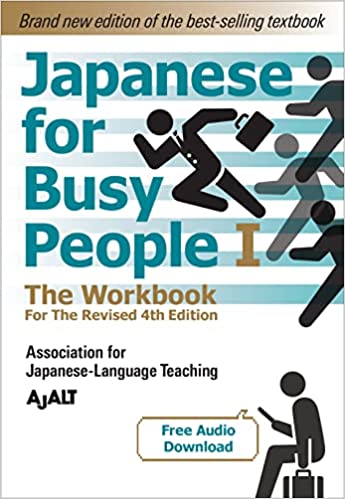
In a way you can judge this textbook by it’s cover! It’s a textbook aimed more at professionals with plenty of vocabulary related to office and business situations. Japanese for Busy People is a series of beginner textbooks that introduces target grammar and vocabulary in a gradual way and the conversations will be helpful for those looking for a crash course in basic business Japanese. While the Romanised English version will allow you to read through the textbook quicker, the Kana version will get you used to reading Hiragana and Katakana. Japanese for Busy People 1 is another great textbook for self-study as it has an answer key to practice questions at the back and there are audio files included to help you practice your listening.
-
- Genre: Comprehensive
-
- Level: Beginner
-
- Language: Japanese Kana or Romanised English version
-
- In the Romanised version, Japanese is written with a Roman alphabet translation
-
- Audio material: Dialogues, phrases, and listening exercises are available for free download
| Pros | Conversations are less stiff and classroom-like and more realistic. There are also clear grammar explanations at the start of each chapter. |
| Cons | There is no Kanji in either version of the textbook so you may hit a Kanji barrier when moving on to your next level. |
Check out these links below to get more details and to purchase the Japanese for Busy People 1 textbook:
Buy on Amazon UK
Buy on Amazon US
Japanese from Zero 1

The Japanese from Zero textbook series are fairly new compared to other textbooks which have been in print for decades. Having said that they have already become one of the most popular choices for new students thanks to their easy going style and up to date vocabulary. The authors have also used the lessons and techniques for over a decade which include adding in Japanese characters previously introduced. Chapters are well-organised and the textbook feels more fun than other Japanese textbooks as it is full of cute characters and illustrations. Since the first book in the series only introduces the Hiragana writing system some find this a slow approach. At the same time this pace is suitable for those studying by themselves and seems to work particularly well with younger students.
-
- Level: Beginner
-
- Genre: Comprehensive
-
- Language: English and Japanese
-
- Japanese is written only in Hiragana in the first textbook
-
- Audio material: No audio is included with the book
| Pros | The textbook is intuitive and visually appealing. The exercises and workbook are integrated into the main textbook so you don’t need to buy a separate workbook and there is an answer key at the back. |
| Cons | No audio is included with the textbook but there are supplementary materials available online however you need to pay to access these. |
Check out these links below to get more details and to purchase the Japanese from Zero 1 textbook:
Buy on Amazon UK
Buy on Amazon US
Japanese the Manga Way

A personal favourite of ours is Japanese the Manga Way. Rather than using it as your main textbook, it’s a fantastic and extremely useful supplement to have. In this book, you get a slice of real Japanese language as each grammar point is illustrated by an actual manga published in Japan. So it’s an entertaining way to learn what many find to be the slightly tedious side of learning Japanese. The in-depth explanations are also incredible easy to follow and provide you with the building blocks you need for Japanese sentence construction. If you’re struggling to get through some grammar points and are on the self-study path we really recommend this book. You don’t need any prior Japanese language learning ability and it definitely helps to have more than the standard explanations you get in most Japanese textbooks.
-
- Level: Beginner to Low-Intermediate
-
- Genre: Grammar and Vocabulary
-
- Language: Mainly English with Japanese for each grammar or vocabulary point
-
- Japanese is written in Hiragana, Katakana and Kanji with Furigana
-
- Audio material: No audio is included with the book
| Pros | Easy to follow teaching style with bite-size lessons reinforced by enjoyable manga content with examples of real life Japanese grammar and vocabulary. |
| Cons | There is no audio material with this book and there are no exercises to practice what you learn. |
Check out these links below to get more details and to purchase Japanese the Manga Way book:
Buy on Amazon UK
Buy on Amazon US
Nihongo So Matome
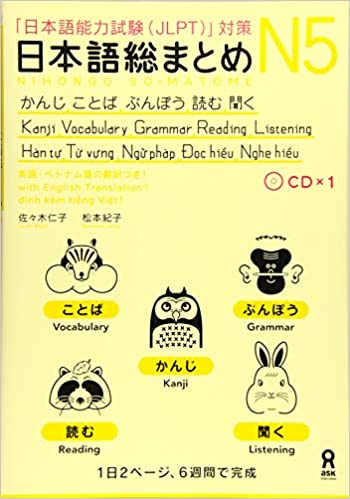
Nihongo So-Matome is an excellent series of revision books for those looking to take the JLPT. It should be mentioned straightaway that these are not meant to be your primary textbook. In Japanese, “Matomeru” means to consolidate so you will find that these books don’t have in-depth explanations of grammar points. They are however extremely well organised and come with an eight week study plan already created for you where you go through 2 pages per day. As you can guess from the cover, the books have lots of pictures to illustrate key points on each page and you get a listening CD in JLPT format to get you used to the exam. From N3 to N1 there are 5 books for every level, while N4 has two books and N5 has just a single book.
-
- Level: Beginner, Intermediate, Advanced
-
- Genre: Comprehensive or Focused on one Element (Vocabulary, Kanji, Listening etc)
-
- Language: English and Japanese. You’ll often find multilingual translations in each book.
-
- Japanese is written in Kanji with Furigana, Hiragana and Katakana
-
- Audio material: CD of the listening content is included with the book
| Pros | The books are extremely well structured and content is broken down into manageable sections. The pictures make it fun to get through all the vocabulary you need to cover. |
| Cons | You will find these are more enjoyable for N5 to N3. N2 and N1 feels more like long vocabulary lists to remember. Also the brief grammar explanations can be weak. |
Check out these links below to get more details and to purchase the Nihongo So Matome N5 textbook:
Marugoto

Marugoto is a series of Japanese textbooks created by the Japan Foundation who organise the JLPT tests. Despite this, the textbooks are designed with the common European language proficiency standards with levels running from the starter A1 texts and going up to the intermediate C2 level. The books are popular as they come in full colour, include photographs, and have high quality audio exercises available for free on the official website. The starter A1 level comprises of two books – Katsudou and Rikai. In Katsudou, learners get to practice listening and speaking skills while Rikai is aimed more at Japanese language structure and working on reading and writing skills.
Marugoto covers a wide range of topics designed for everyday life in Japan such work life, holidays, school and transportation. The textbooks also covers modern vocabulary for social networking, emails and texts as well as important Japanese food and cultural sections.
-
- Level: Beginner, Intermediate
-
- Genre: Comprehensive
-
- Language: English and Japanese
-
- Japanese is written in Kanji with Furigana, Hiragana and Katakana
-
- Audio material: Lesson material and exercises are available on the Marugoto website.
| Pros | Very friendly for beginner with stimulating, colourful content, and plenty of online material for the lower two levels. |
| Cons | There are no accompanying online exercises and supplementary materal for higher levels. |
Check out these links below to get more details and to purchase the Marugoto A1 Katsudou textbook:
A Dictionary of Japanese Grammar

This is the first in a set of three must-have Japanese grammar dictionaries: Basic, Intermediate, and Advanced. They all are highly recommended by Japanese teachers for students of Japanese and the Basic Japanese Grammar book is even known as the “Yellow Book” or “the Bible” among some expats. It has over 200 grammar points that covers everything you will need to know to construct sentences in Japanese. The books introduce grammar points in English alphabetical order and each entry provides a detailed explanation with typically several example Japanese sentences using that grammar point. So while they are dictionaries, they contain a lot more useful information then you would normally expect from a dictionary.
If you are at a more advanced level, you’ll probably want to look at the blue Dictionary of Intermediate Japanese Grammar book or the red Dictionary of Advanced Japanese Grammar book.
-
- Level: Beginner, Intermediate, Advanced
-
- Genre: Grammar Dictionary
-
- Language: English and Japanese
-
- Japanese is written in Kanji with Furigana, Hiragana and Katakana
-
- Audio material: No audio is included with the book
| Pros | Grammar points are clearly explained and you can learn the difference between similar grammar points that are often confused with each other. It is often noted to be far superior to anything you can find on Internet blogs. |
| Cons | This is not a grammar textbook but a dictionary as stated on the cover. Some may also find the explanations to be technical. |
Check out these links below to get more details and to purchase the Dictionary of Basic Japanese Grammar:
Basic Kanji Book
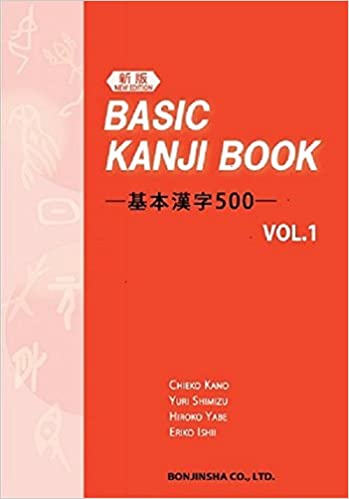
One of the most important things for beginners when studying Japanese is Kanji. For some Kanij can be a painful process of memorising stroke orders and knowing the several ways to read it. This is where you need a solid textbook to guide you through the first 500 characters and here the Basic Kanji Book steps up and is widely recognised for being one of the most helpful textbooks.
Book 1 covers the basic 250 characters and the Book 2 goes through the next 250. Each lesson introduces 10 Kanji and shows you how the radicals are composed and how they are used in real life such as how they make up common Japanese family names. You also get fun games to test what you have learned where you can navigate shopping centres or TV guides. There is plenty of reading and writing exercises too where you can practice writing out Kanji characters.
-
- Level: Beginner
-
- Genre: Kanji textbook (Reading and Writing)
-
- Language: English and Japanese
-
- Japanese Kanji has with Furigana so it is easy to read
-
- Audio material: No audio is included with the book
| Pros | Perfect for beginner level students and focuses on reading comprehension and writing skills with plenty of practice sections for each character. |
| Cons | You need to prepare yourself for a textbook with no colour illustrations. |
Check out these links below to get more details and to purchase the Basic Kanji Book:
Read Real Japanese

There are actually two books that make up the Read Real Japanese series. You have the Read Real Japanese Essays book comprised of six essays and the Read Real Japanese Fiction book with six short stories. In both, you’ll find the original Japanese text on the right page and then the notes in English on the facing left hand page. What’s great about the notes is they provide key vocabulary and phrases but not full translations. So you’ll be improving your comprehension and using your grammar knowledge while reading authentic Japanese essays or fiction written for a Japanese audience and not students.
At the back of the book there’s also a further dictionary and notes section providing more grammar insights and cultural background. The audio narration will be helpful for those who want to get used to the sound and rhythms of Japanese as well as the speed at which it is typically spoken.
-
- Level: Intermediate
-
- Genre: Reading Comprehension
-
- Language: Japanese with English notes
-
- Japanese is written in Kanji with Furigana, Hiragana and Katakana
-
- Audio material: Free Audio Download is available containing narrations for the essays
| Pros | Several contemporary essays from famous authors including Haruki Murakami and notes which explain cultural contexts and usage |
| Cons | Not accessible for beginner students as you will need to have intermediate level Grammar and Vocabulary knowledge. |
Check out these links below to get more details and to purchase the Read Real Japanese Essays book:
Ippo Ippo Japanese Textbook Recommendations
Here are a few recommendations that Elly from Ippo Ippo Japanese has kindly passed on. If you’ve been reading our monthly Japanese Events Calendar, you’ll recognise Ippo Ippo as they have frequent online and in-person events. Elly is an experienced Japanese tutor, and for those wanting to study Japanese in a group course, we recommend joining their Japanese for Beginners course as well as the JLPT courses.
Beginner & Lower Intermediate Level
First up, the main textbooks I use with learners from beginner to lower intermediate level are Genki I and II. These books are the ones I initially used to learn Japanese myself, so full disclosure: I may have a slight nostalgia bias! However, my favourite thing about them as a teacher is the consistency of format, the number of practice exercises and – perhaps most importantly – the sheer amount of accompanying materials you can find online. These include online quizzes, games, podcasts, videos and even special apps. That said, Genki does have its downsides, including overly wordy grammar explanations, as well as the fact that it is designed to be used in a group class setting. It also skips over some very important practical language. For this reason, I personally supplement it with other materials including the Irodori textbooks, and would not particularly recommend Genki if you’re studying by yourself.
Advanced Japanese Level
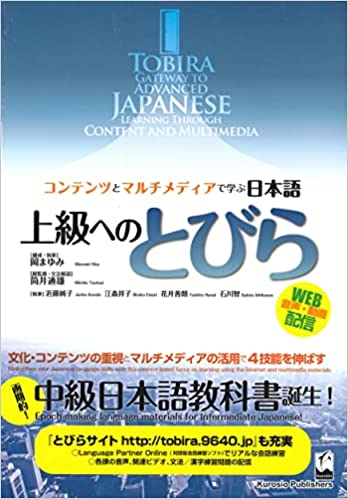
Tobira: Gateway to Advanced Japanese is a book I have used as both a learner and teacher, and it is one I’ve recently used parts of with some of my advanced students (N3 to N2 level). I recommend this book to anyone who enjoys going deep into specific topics (e.g. about Japanese culture, politics or language), as well as to those keen to get some extra reading practice. If you have a teacher or study buddy to work with, there are also plenty of speaking roleplay activities to have a go at, as well as extra videos and practice materials you can access online. Although I’m yet to try it out, the same publishers also recently released a new book entitled Tobira 1: Beginning Japanese.
First Kanji Textbook

Kanji Look and Learn (and the accompanying workbook) is a solid choice when it comes to learning your first 512 kanji, taking you right from the start all the way up to JLPT N3 level. While I know many people prefer to learn kanji through apps or flashcards, if learning to write by hand is something you don’t mind (or maybe even enjoy!), I recommend checking out this textbook. Unlike many of its peers, it comes with mnemonic hints for every kanji, as well as plenty of practice exercises in the workbook, which I find helps students to apply the kanji they’ve learnt to real-life sentences – in particular when it comes to grasping when (or when not) to add okurigana.
What are the key features to look for in a Japanese textbook?
Key features to look for in a Japanese textbook include comprehensive grammar explanations, engaging exercises with answer keys, vocabulary lists with kanji characters, cultural insights, audio resources for pronunciation practice, and a progressive lesson structure that builds upon previous concepts.
Japanese Textbooks and Further Japanese Learning Resources
We hope that you found our Japanese textbook recommendations above to be helpful. Please feel free to comment below if you have used any of them yourself and how you found them in your experience. Also, if you are looking for ways to learn using online resources check out our article on the best ways to learn Japanese online.

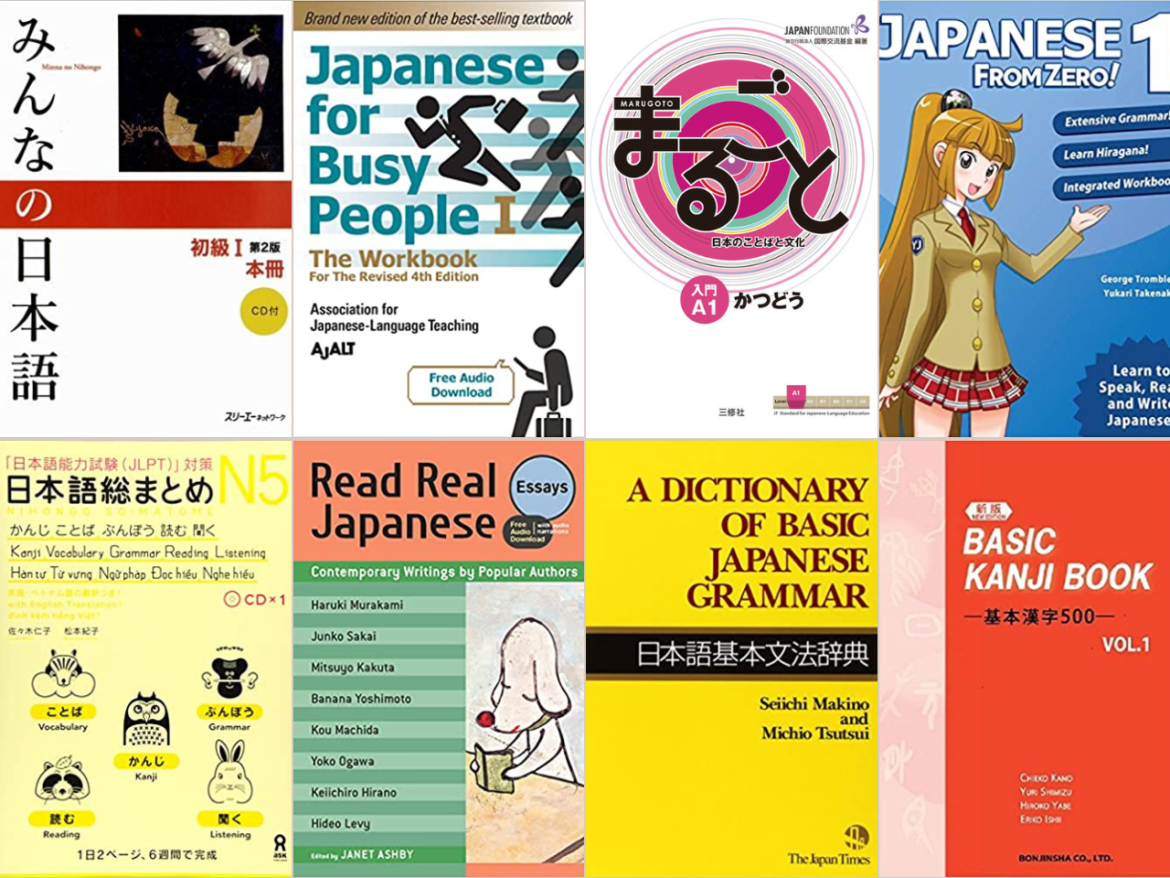

2 comments
Everything is very open with a very clear clarification of the challenges. It was truly informative. Your site is useful. Thanks for sharing!
[…] you can click here to read an abbridged version of this post in the Best Japanese article The Top 14 Textbooks to […]
Comments are closed.